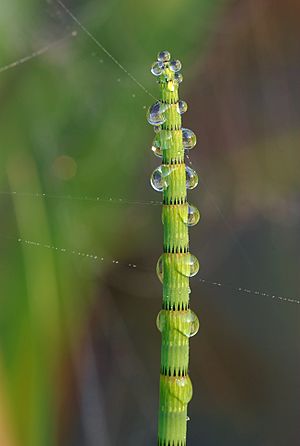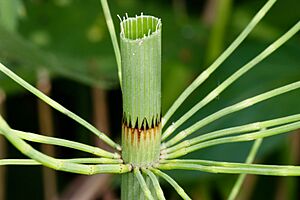Water horsetail facts for kids
Quick facts for kids Water horsetail |
|
|---|---|
 |
|
| Scientific classification | |
| Genus: |
Equisetum
|
| Species: |
fluviatile
|
The water horsetail (also called swamp horsetail) is a special type of plant. It often grows in big groups near freshwater, like along riverbanks or in shallow ponds. You can also find it in swamps, ditches, and other slow-moving or still water with muddy bottoms.
This plant is a perennial herb, meaning it lives for many years. It grows to be about 30 to 100 centimeters tall, but sometimes even taller! Its stems are dark green and smooth, usually 2 to 8 millimeters wide. Each stem has about 10 to 30 small ridges.
At every joint on the stem, there's a ring of tiny, black-tipped scale leaves. These leaves are about 5 to 10 millimeters long. Many stems also have short branches that grow outwards, usually 1 to 5 centimeters long. The longest branches are found in the middle of the stem. These side branches are thin, dark green, and have small rings of five scale leaves at each joint.
One cool thing about the water horsetail is its stem. It has the biggest central hollow of all the horsetail plants. About 80% of the stem's width is usually hollow inside! The stems can easily break apart at their joints. Both the stems that produce spores and those that don't look very similar.
Contents
How Water Horsetail Reproduces
The water horsetail can make more plants in two ways: using spores or by growing new shoots from its underground stems called rhizomes. Most new plants actually grow from these rhizomes.
Spores are like tiny seeds, but they are not seeds. They are made in blunt-tipped cones that grow at the top of some stems. These spore cones are yellowish-green and are about 1 to 2 centimeters long and 1 centimeter wide. They have many scales arranged in tight rings.
Where Water Horsetail Lives
You can find the water horsetail all over the cooler parts of the Northern Hemisphere. This includes places like Eurasia (Europe and Asia), stretching south to central Spain, Italy, the Caucasus mountains, China, Korea, and Japan. In North America, it grows from the Aleutian Islands all the way to Newfoundland, and south to states like Oregon, Idaho, Montana, Wyoming, West Virginia, and Virginia.
Is Water Horsetail Invasive?
Sometimes, the water horsetail is seen as an invasive species. This means it can grow very quickly and take over other plants, especially in gardens. It's a very tough plant! If you want to plant it in a garden, it's a good idea to put its rhizomes in a container. This helps stop it from spreading too much.
Water Horsetail vs. Marsh Horsetail
People sometimes mix up the water horsetail with another plant called the marsh horsetail (E. palustre). But there are ways to tell them apart! The marsh horsetail has rougher stems with fewer ridges (only 4 to 8). Its stem also has a smaller hollow inside. Plus, its spore cones are longer, about 2 to 4 centimeters long.
Uses of Water Horsetail
Throughout history, people have used the water horsetail for different things.
Historical Uses
Both Europeans and Native Americans used water horsetail stems for scrubbing, sanding, and filing. This is because the stems have a lot of silica in them, which is a hard, gritty material.
In early spring, the young shoots of the plant were sometimes eaten. Ancient Greeks and Romans used it as medicine to stop bleeding and help with kidney problems, ulcers, and tuberculosis. Ancient Chinese people used it to treat some eye problems.
Animal Food and Environmental Uses
The rootstocks and stems of water horsetail are sometimes eaten by waterfowl (birds that live near water).
Horsetails can also absorb heavy metals from the soil. Because of this, they are sometimes used in special tests to check for metals in the environment.
Fodder for Animals
According to Carl Linnaeus, a famous scientist, reindeer will eat this horsetail even if they refuse regular hay. He also noted that in northern Sweden, farmers would cut this plant to feed their cows. They believed it helped their cows produce more milk. However, horses usually won't eat it.
See also
 In Spanish: Equiseto mayor para niños
In Spanish: Equiseto mayor para niños


